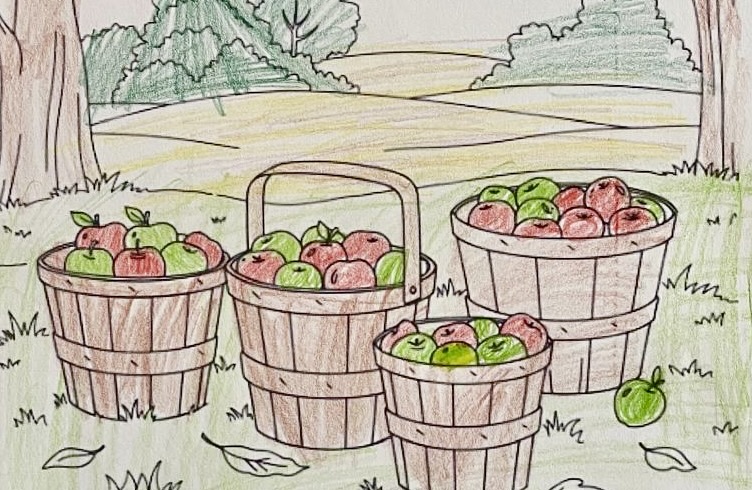
How to use: experiment with making the slope steeper and watch how it affects the speed of the ball. Try it with a real ball and a plank of wood. For age and grade appropriate lesson plan plus teacher tips scroll down below. For droid devices, the rolling ball may display best if you turn you phone sideways to display.
🍂 Rolling Into Fall: Ramp Physics 🍂
Activity Title: Explore Motion and Forces Through Seasonal Fun
Season: Fall/Autumn Physics Discovery
Time: 30-45 minutes
Learning Objectives (K-1st Grade)
- Observe that balls roll faster down steeper slopes
- Use simple words to describe fast and slow motion
- Practice counting and basic comparison skills
- Develop fine motor skills through hands-on exploration
Standards Alignment
- NGSS K-PS2-1: Plan and conduct investigations to compare effects of different strengths/directions of pushes and pulls
- Math K.MD.A.1: Describe measurable attributes of objects (faster/slower)
- Language Arts: Use descriptive words for motion and speed
Key Vocabulary
- Roll – When something turns over and over as it moves
- Fast – Moving quickly
- Slow – Moving not quickly
- Slope/Ramp – A surface that goes up or down at an angle
- Steep – Goes up or down a lot (like a big hill)
- Gentle – Goes up or down just a little (like a small hill)
Materials Needed
For Classrooms:- Computer/tablet with physics simulation
- Wooden blocks or books for ramps
- Small balls (tennis balls, rubber balls)
- Toy cars (optional)
- Device to view the simulation
- Cardboard or cutting board
- Pillows or books to prop up ramp
- Small ball or toy car
Show children a ball and ask: “What happens when we roll a ball down a hill? Will it go fast or slow?”
Use the physics simulation together. Let children press the different slope buttons and watch the ball. Ask them to clap when they see the ball going “super fast!”
Create a gentle slope with books/cardboard. Roll a ball down. Then make it steeper and roll again. Let children feel the difference.
Practice using words: slow, fast, faster, fastest. Have children move their bodies like slow turtles, then fast rabbits!
Connect to autumn by discussing how leaves fall down from trees – they go faster when the wind pushes them, just like balls go faster on steeper ramps! You can collect fallen leaves and drop them from different heights.
Learning Objectives (2nd-3rd Grade)
- Understand the relationship between slope angle and speed
- Make predictions and test hypotheses about motion
- Record and compare data using simple charts
- Use mathematical language to describe patterns
Standards Alignment
- NGSS 2-PS1-1: Plan and conduct investigations to describe and classify materials
- Math 2.MD.D.10: Draw picture graphs and bar graphs to represent data
- Math 3.MD.B.3: Draw scaled picture graphs and bar graphs
- Language Arts: Use scientific vocabulary and record observations
Key Vocabulary
- Angle – How steep or tilted a surface is
- Speed – How fast something moves
- Slope – A slanted or tilted surface
- Gravity – The force that pulls things down toward the ground
- Motion – When something moves from one place to another
- Predict – To guess what will happen before you test it
- Observe – To watch carefully and notice what happens
- Data – Information you collect from an experiment
Materials Needed
For Classrooms:- Computer/tablet with physics simulation
- Various ramp materials (wood, cardboard, plastic)
- Different balls (ping pong, tennis, rubber)
- Stopwatch or timer
- Recording sheets
- Device for simulation
- Cardboard or cookie sheet
- Various household balls/round objects
- Measuring tape or ruler
- Paper for recording
Ask students to predict: “Which slope angle will make the ball travel fastest? Why do you think so?”
Use the simulation to test each slope angle (5°, 15°, 30°). Record the final speed shown for each angle.
Create three different slope angles using books. Time how long it takes balls to roll down each slope. Record results.
Create a simple bar graph showing speed or time for each slope angle. Discuss patterns observed.
Compare hypothesis with results. What did we learn about slopes and speed?
Explore how autumn relates to physics! Investigate different natural ramps outdoors – hills, playground slides, or even large fallen logs. Compare how pinecones, acorns, and leaves move down different slopes. This connects classroom learning to seasonal outdoor exploration.
Learning Objectives (4th-5th Grade)
- Understand the scientific relationship between gravitational force and inclined planes
- Calculate and compare acceleration rates on different slopes
- Design controlled experiments with multiple variables
- Create detailed data tables and interpret scientific graphs
- Explain physics concepts using proper scientific terminology
Standards Alignment
- NGSS 4-PS3-1: Use evidence to construct explanations relating speed of objects to energy
- NGSS 5-ETS1-1: Define criteria and constraints of a design problem
- Math 5.MD.A.2: Make line plots to display measurement data
- Math 4.NBT.B.5: Multiply multi-digit numbers (for calculating averages)
- CCSS.ELA-LITERACY.SL.5.4: Report on a topic using appropriate facts and relevant details
Key Vocabulary
- Acceleration – The rate at which an object’s speed increases over time
- Inclined plane – A flat surface set at an angle (a simple machine)
- Gravitational force – The force that pulls objects toward Earth’s center
- Kinetic energy – Energy that an object has because it is moving
- Potential energy – Stored energy that an object has because of its position
- Velocity – Speed in a specific direction
- Hypothesis – A testable prediction about what will happen in an experiment
- Variable – Something that can be changed in an experiment
- Control – Keeping certain things the same to make a fair test
- Friction – A force that slows down moving objects when they rub against surfaces
Materials Needed
For Classrooms:- Computer/tablet with physics simulation
- Protractor for measuring angles
- Various spherical objects of different masses
- Measuring tape
- Digital timer/stopwatch
- Graphing materials or software
- Scientific notebooks
- Device for simulation access
- Measuring tools (ruler, measuring tape)
- Various balls and round objects
- Timer app on phone
- Graph paper or spreadsheet software
- Scientific journal/notebook
Students develop testable questions: “How does the angle of incline affect the acceleration of a rolling object?” Write formal hypotheses with reasoning.
Use the physics simulation systematically. Record distance, speed, time, and angle for each trial. Calculate acceleration using the formula: acceleration = (final speed – initial speed) ÷ time.
Design experiments testing multiple variables: angle, ball mass, ramp surface material. Create data tables with at least 3 trials per condition.
Create line graphs showing the relationship between angle and speed. Calculate average speeds and identify linear relationships. Use mathematical reasoning to explain patterns.
Write formal conclusions explaining the relationship between gravitational force, inclined planes, and acceleration. Use evidence from both digital and physical experiments.
Research and discuss how inclined planes are used in engineering: ramps, roads through mountains, wheelchair accessibility, conveyor belts.
Connect this physics exploration to autumn engineering challenges! Students can design and build leaf collection ramps, investigate how road engineers design mountain highways for safety in fall weather, or explore how playground equipment uses inclined plane principles. This builds understanding of how physics principles solve real-world problems in seasonal contexts.
- Research famous inclined planes in architecture and engineering
- Design an accessibility ramp for your school with proper angle calculations
- Investigate how ski slopes use physics principles
- Create a physics presentation explaining inclined planes to younger students






